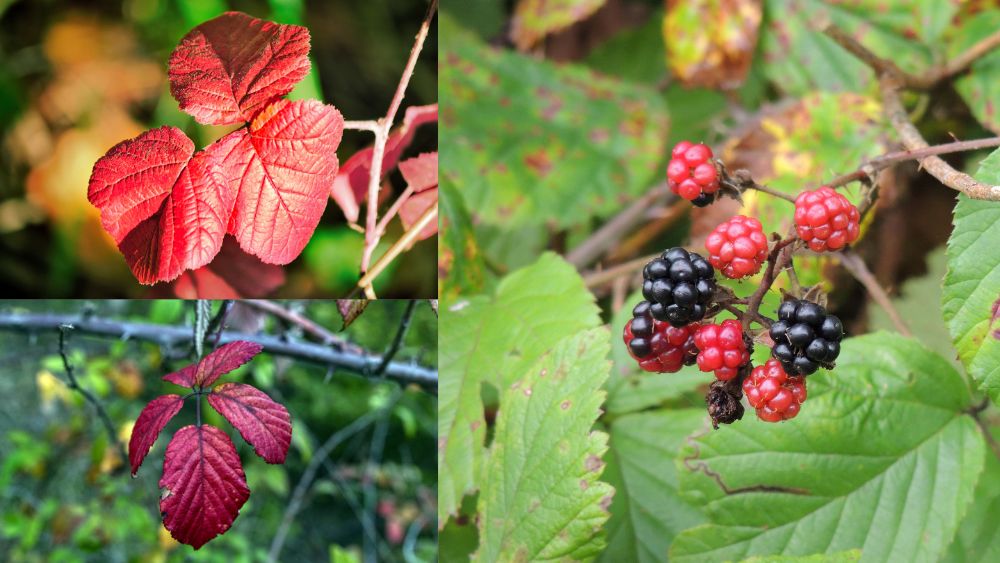Blackberries are a delicious fruit that is relatively easy to grow, but if you suddenly find the leaves of your blackberry plants turning red, what should you do?
The most common reasons blackberry leaves turn red are lack of nutrients, watering the plant too much, disease, or frost. If your blackberry leaves suddenly turn red, it’s likely one of these four causes.

4 Causes of Blackberry Leaves Turning Red
Let’s take a closer look at the four main causes of blackberry leaves turning red.
1. Lack of Nutrients
Blackberry plants need certain nutrients in order to survive and thrive, so if they are missing some, they won’t have what they need to grow right. Nitrogen and phosphorus are the most important nutrients for blackberries, but they also need zinc, iron, and manganese.
The leaves of your blackberry plant can turn other colors as well, such as yellow, but when they turn red or purple, it’s usually a deficiency of phosphorus or nitrogen.
You can do one of two things when this happens. The first one is to add some fertilizer containing NPK (nitrogen, phosphorus, and potassium), which are the three main nutrients that all plants need.
The second one is to add some compost, which enriches the soil and helps it drain better, both of which are crucial for healthy blackberry plants. You can also test your soil to make sure it has the right pH level, which for blackberries is 5.5 to 6.5.
2. Overwatering
Blackberry plants need water, but they can’t have too much water or their leaves will turn different colors, sometimes even falling off at some point. The best way to water blackberries the proper amount is to hold off on watering them until the top two to four inches of the soil are dry.
You should also soak down to a two-foot depth because that’s how deep the roots are. The soil also needs to drain well because if it doesn’t, the plant can easily become waterlogged and that could lead to root rot.
Make sure your soil is never compacted or recessed, and if it’s high in clay, add one or two inches of compost either monthly or every other month to improve drainage.
3. Diseases
Root rot is common in berry plants. Also called crown rot, this disease can cause leaves to turn yellow, brown, or red, and if it lasts too long, the leaves can fall off of the plant. Root rot is usually a problem in areas that drain poorly.
Some people raise their plant beds so that the drainage is a little better, but you can also repot the plant with fresh potting soil, which works wonders.
Blackberry plants can also get a fungal disease called rust, which doesn’t kill them but can reduce the number of berries that plants produce. If the weather has been very warm and wet, rust is can occur.
Leaf scorch can also turn berry leaves red, but this disease is usually transmitted by aphids. This means that controlling your aphid and mite population will greatly reduce the odds of experiencing leaf scorch.
4. Frost
Berries prefer cooler temperatures but harsh frost can turn their leaves various colors, including red. A lot of cold weather and frost can even make the leaves fall off and die, but you can usually do something about it before it gets to this point.
Blackberries do best in growing zones 4-10, and early or late frosts tend to be worse. To prevent the frost from doing too much damage, you can provide mulch to give the plants some insulation, move the plants inside, or place them in a greenhouse.
With berries, you have to pay attention to frost warnings because even though they can handle a few frosts and prefer cooler weather, too much frost can damage the plants.
Be prepared to bring them inside if there is a risk of frost.
What Does It Mean When Leaves Turn Red?
It is normal for blackberry leaves to turn red in the fall, but if they do this in the spring or summer, you likely have a problem.
The pH level of blackberry soil needs to be slightly acidic, and to be sure the pH number is correct, make sure you buy some type of meter or other device that has the specific purpose of testing your soil.
You can also amend the soil if it isn’t the right number, and you can do this by adding composted manure, coffee grounds, or peat moss.
Conclusion
There are several causes of red leaves on blackberry plants the most common being frost, nutritional deficiencies, overwatering, and diseases. Most of these things are easy to fix and even better, most do not necessarily mean the plant will die. You just have to learn to recognize them first.
I am an accredited practicing dietitian, experienced gardener and a dedicated cook. I love writing and sharing my experience so you can learn from my successes and mistakes.
